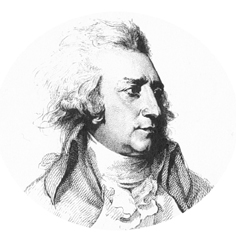|
 |
 |
 |
 |

|  | Henry Fuseli, painter (1741-1825) | | |  | 
Fuseli was born in Zurich on 7 February 1741, the second son of the
eighteen children of Elisabeth Waser and Johann Caspar Füssli. Although
educated as a theologian and ordained as a Zwinglian minister in 1761,
Fuseli pursued a wide range of humanist studies, developing an
enthusiasm for classical philology under the influence of Johann Jakob
Breitinger, and becoming proficient in English, French, and Italian. He
was introduced by Johann Jakob Bodmer, the mentor whom he most revered,
to Homer, the Nibelungenlied, Dante, Shakespeare, and Milton, later the
principal sources of his art. His associations with the Sturm und Drang
movement were close.
In 1762 he and his close friend and fellow
theology student Johann Caspar Lavater published a pamphlet attacking a
corrupt Zurich official. As a result of this action, the two found it
expedient to leave the city. In 1763 they went to Berlin. In 1763, he
moved to London at the suggestion of the British ambassador in Berlin,
who had been impressed by his drawings.
Encouraged by Sir Joshua
Reynolds in 1768 to become a painter, Fuseli traveled to Italy in 1770
in the company of John Armstrong. He sought inspiration from classical
sculpture, Michelangelo, and mannerist art. He studied in Rome 1770-78
under Anton Raffael Mengs, and was the centre of an international group
of artists including Sergel, Banks, Runciman, Abildgaard, Romney,
Northcote and John Brown.
Early in 1779 he returned to England,
taking Zürich on his way. Returning to London in 1780, Fuseli
established his reputation with The Nightmare. Involved from the outset
in 1786 with John Boydell's scheme for employing the most talented
artists of the day on a Shakespeare Gallery, he devoted most of his
time to paintings of Shakespearean themes until the opening of the
gallery in 1789. In emulation of this project, he executed during the
1790s forty-seven paintings for a Milton Gallery in which the work was
entirely his. Although many of these works were bought by his principal
patron, Thomas Coutts, the exhibitions in 1799 and 1800 were not a
public success.
In 1788 Fuseli married Miss Sophia Rawlins, who was originally one of his models.
Fuseli was elected an Associate of the Royal Academy of Arts in 1788, a
full Academician in 1790, and Professor of Painting in 1799; he was
obliged to relinquish the latter post after his election as Keeper in
1804, the year in which Benjamin Robert Haydon became his pupil, but
the statutes were altered to allow him to resume it in 1810.
In his later years he was influential because of his writings and lectures on art history and theory.
Fuseli died at Putney Hill near London on April 16, 1825, at the age of eighty-four.
|  | < |
|
|
|
|
|



